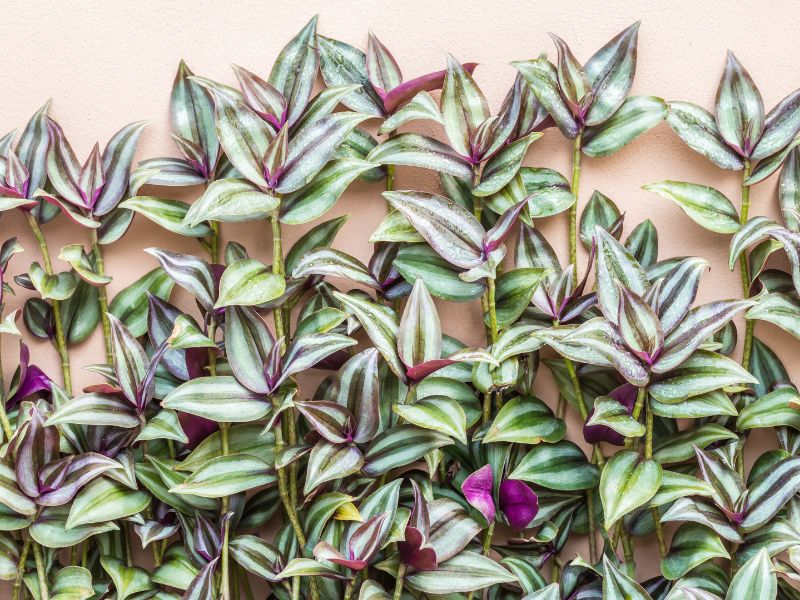
xr:d:DAFXJfuB69Y:2,j:44868572941,t:23010905
I. Introduction
A. Overview of Wandering Jew Plants
Wandering Jew plants, scientifically known as Tradescantia species, are popular ornamental houseplants valued for their colorful foliage and easy-care nature.
B. Concerns About Plant Toxicity
Despite their aesthetic appeal, there are concerns about the potential toxicity of wandering Jew plants, particularly for pets such as cats, who may come into contact with these plants indoors.
C. Importance of Understanding Potential Risks
As responsible pet owners, it’s crucial to be aware of any potential risks posed by common household plants like wandering Jew to ensure the safety and well-being of our furry companions.
II. Understanding Wandering Jew Plants
A. Botanical Characteristics
- Genus and Species
Wandering Jew plants belong to the genus Tradescantia, encompassing several species known for their trailing vines and colorful leaves, including Tradescantia zebrina, Tradescantia fluminensis, and Tradescantia pallida.
- Common Varieties
Varieties of wandering Jew plants may vary in leaf shape, color, and patterning, with some featuring striped or variegated foliage in shades of green, purple, and silver.
B. Growth Habits
- Trailing Vines
Wandering Jew plants typically produce long, slender stems that trail or cascade down from hanging baskets or containers, making them popular choices for adding greenery to shelves, mantels, and other elevated spaces.
- Vibrant Foliage
One of the distinguishing features of wandering Jew plants is their vibrant, eye-catching foliage, which may feature bold stripes, contrasting colors, or intricate patterns, adding visual interest to indoor environments.
C. Cultivation and Care
Wandering Jew plants are relatively low-maintenance and adaptable to a wide range of growing conditions, thriving in bright, indirect light and well-draining soil. Regular watering and occasional fertilization help maintain their health and vibrancy.
III. Toxicity Concerns for Cats
A. Identification of Toxic Compounds
- Oxalates
Wandering Jew plants contain calcium oxalate crystals, which are toxic to cats if ingested. These crystals can cause irritation and inflammation in the mouth, throat, and gastrointestinal tract upon contact or ingestion.
- Potential Symptoms of Ingestion
Signs of wandering Jew plant toxicity in cats may include drooling, vomiting, diarrhea, and difficulty swallowing. In severe cases, cats may experience respiratory distress or swelling of the mouth and throat, requiring immediate veterinary attention.
B. Impact on Cats’ Health
- Gastrointestinal Irritation
Ingestion of wandering Jew plants can lead to gastrointestinal upset in cats, causing discomfort and potential dehydration. Prompt veterinary care is essential to address symptoms and prevent complications.
- Potential Allergic Reactions
Some cats may be more sensitive to the toxins present in wandering Jew plants, experiencing allergic reactions such as itching, redness, or swelling upon contact with the plant’s foliage.
C. Risk Factors and Severity
The severity of toxicity depends on various factors, including the amount of plant material ingested, the size and health of the cat, and the promptness of treatment. Cats with pre-existing health conditions may be at higher risk of complications.
IV. Prevention and Management
A. Creating a Safe Environment
- Placement of Plants
To prevent accidental ingestion, place wandering Jew plants out of reach of curious cats or consider displaying them in hanging baskets or mounted planters where pets cannot access them.
- Alternative Options for Indoor Greenery
Opt for pet-safe houseplants that are non-toxic to cats, such as spider plants, Boston ferns, or African violets, to beautify your home without posing a risk to your furry friends.
B. Educating Pet Owners
- Awareness of Potential Risks
Educate pet owners about the potential toxicity of wandering Jew plants and other common household plants, encouraging them to research plant safety before introducing new greenery into their homes.
- Steps to Take in Case of Ingestion
Instruct pet owners on the importance of contacting their veterinarian immediately if they suspect their cat has ingested wandering Jew plants, providing information on potential symptoms and treatment options.
C. Veterinary Care and Treatment
Seek prompt veterinary care if your cat shows signs of plant toxicity, as early intervention can help alleviate symptoms and prevent complications. Your veterinarian may recommend supportive care, such as fluid therapy or anti-inflammatory medication, to help your cat recover.
V. Conclusion
A. Recap of Wandering Jew Plant Toxicity
While wandering Jew plants are prized for their beauty and resilience, it’s essential to be mindful of their potential toxicity to cats and other pets, taking precautions to minimize the risk of accidental ingestion.
B. Encouragement for Responsible Plant Ownership
As responsible pet owners, we have a duty to create a safe environment for our furry companions, which includes carefully selecting and managing indoor plants to ensure they pose no harm to our pets’ health and well-being.
C. Importance of Prioritizing Pet Safety
By staying informed about plant toxicity and taking proactive measures to safeguard our pets, we can enjoy the beauty of indoor greenery while providing a safe and nurturing environment for our beloved feline friends.
